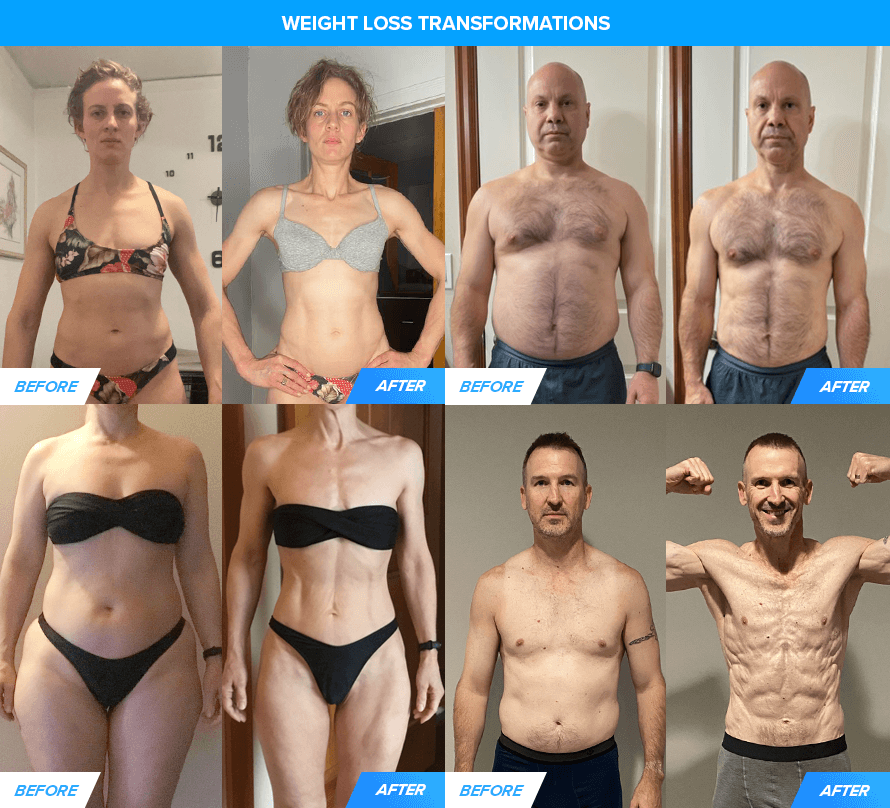“What should my macros be to lose weight?”
It sounds like a simple question, but it stumps even the most experienced dieters. And it’s no wonder why—misinformation about counting macros for fat loss is everywhere.
For instance, social media fat loss “specialists” often claim their “unique” approach is the only way to shed pounds quickly and healthily.
But the truth?
There’s no single “perfect” macro ratio for fat loss that works for everyone. That said, science does suggest some macro ratios work better for fat loss than others.
What are these evidence-based percentages?
Here’s the breakdown:
- Protein: 30-to-40% of calories
- Carbohydrates: 30-to-50% of calories
- Fat: 20-to-30% of calories
In this article, you’ll learn why these ratios work, how to calculate them based on your lifestyle, and how to adjust them as your body changes. By the end, you’ll have a science-backed plan to make fat loss as fast and simple as possible.
Key Takeaways:
- Tracking your macros is essential for weight loss, as it helps you control your calorie intake while preserving muscle, maintaining energy, and supporting overall health.
- There’s no single “perfect” macro ratio for fat loss, but some strategies work better than others.
- The first step in counting macros for weight loss is creating a calorie deficit. Most people have success by eating 20-to-25% fewer calories than they burn each day.
- A balanced macro ratio for fat loss generally includes 30-to-40% of calories from protein, 30-to-50% from carbohydrates, and 20-to-30% from fat.
- As you lose weight, you’ll need to adjust your macros to keep seeing results. When weight loss stalls, a good strategy is to lower your daily calorie intake by 100-to-150 calories by reducing carbs.
Table of Contents
+
What Are Macros and Why Do They Matter for Weight Loss?

A macronutrient (“macro”) is a nutrient your body needs in large amounts to function properly. While the term technically includes minerals, we’ll focus on the three macros that matter most for weight loss: protein, carbohydrates, and fat.
Tracking your macros helps you control your calorie intake and improve your body composition. It’s especially effective while dieting to lose weight because it allows you to manage your energy levels and optimize your health while dieting.
Simply put, balancing your macros makes losing fat more healthy, efficient, and sustainable.
What Are the Perfect Macro Percentages for Weight Loss?
“Macro percentages” or a “macro ratio” refers to the proportion of your daily calorie intake that comes from protein, carbohydrates, and fat.
Despite what many diet “gurus” claim, there’s no magic macro ratio for fat loss. Research shows you can lose weight with a variety of macronutrient distributions—what matters most is that you maintain a calorie deficit.
That said, research also suggests that some strategies make fat loss easier for most people:
- Eating more protein helps preserve muscle and can keep you feeling full, which typically makes dieting healthier and more straightforward.
- Consuming a moderate amount of carbs keeps your energy levels up, which makes dieting more enjoyable and sustainable. This is especially true if you lift weights since low-carb diets can drain your energy and crush your motivation to train.
- Eating an adequate amount of healthy fats is paramount for hormone production and overall well-being.
In other words, while there’s no single “perfect” macro ratio, science suggests certain distributions are more effective for fat loss than others.
How to Count Macros to Lose Weight: Science-Based Ratios

As we’ve established, there’s no one-size-fits-all macro ratio for fat loss. However, research gives us clear guidelines on macro breakdowns that work well for most people.
Don’t just take my word for it—check out some of the clients from my body transformation coaching program. They followed the evidence-based macro ratios we’re about to cover and achieved incredible results:

Ready to see similar success?
Here’s your step-by-step guide to counting macros for weight loss, designed to make reaching your body composition goals as efficient and straightforward as possible.
Step 1: Calculate Your Daily Calorie Intake
To lose fat, you have to eat fewer calories than you burn.
But how many calories should you aim for?
Studies show that eating 20-to-25% fewer calories every day is the sweet spot. It’ll help you shed fat lickety-split without losing muscle or wrestling with excessive hunger, lethargy, and the other hobgoblins of low-calorie dieting.
You have two options for figuring out how many calories this translates to for you:
- Use the Legion Calorie Calculator: This is the easiest way to get an accurate calorie target.
- Estimate calories based on your weight and activity level: Eat 8-to-12 calories per pound of body weight per day depending on how much exercise you do.
Here’s how to choose the exact number based on how active you are:
- Sedentary (little to no exercise): Go with the lowest end—8 calories per pound.
- Lightly Active (1-to-3 hours of exercise per week): Pick the middle of the range—9-to-10 calories per pound.
- Moderately Active (4-to-7 hours of exercise per week): Opt for the high end—12 calories per pound.
- Very Active (8+ hours of training per week): You may need more than 12 calories per pound to maintain a healthy deficit (~14-to-16 calories), depending on how much energy you burn. Because activity levels vary so much, the Legion Calorie Calculator is your best bet for pinpointing your exact needs.
Step 2: Set Your Macro Ratio for Fat Loss
Now that you have your daily calorie target, divide these calories into protein, carbs, and fats. Here’s an evidence-based macronutrient breakdown for weight loss:
- Protein: Consume 1 gram of protein per pound of body weight per day, and if you’re very overweight, 0.6-to-0.8 grams per pound of body weight per day is sufficient. This usually comes out to around 30-to-40% of daily calories.
- Carbs: Consume 30-to-50% of your daily calories from carbohydrate—about 0.75-to-2 grams of carbs per pound of body weight per day for most people.
- Fat: Consume 20-to-30% of daily calories from fat—about 0.2-to-0.4 grams of fat per pound of body weight per day for most people.
Step 3: Adjust Based on Your Results
Many people mistakenly believe that once they calculate their macros for weight loss, they can keep using the same numbers forever—but that’s not how the body works. As you lose weight, your body burns fewer calories, both because you weigh less and your metabolism slows to conserve energy.
Your body also becomes more efficient at using the calories it does get. It even reduces spontaneous movement, like fidgeting or moving around, which further decreases calorie expenditure.
Over time, these changes shrink your calorie deficit, and weight loss slows. To continue losing fat at this point, you need to widen the gap between the energy you consume and the energy you burn.
Here’s how:
- When weight loss stalls despite “maxing out” on exercise and planning and tracking your food intake precisely, reduce your daily calorie intake by 100-to-150 calories per day by lowering your carb intake. This will usually “buy” you another 7-to-10 days of fat loss.
- When weight loss stalls again, reduce your energy intake by a further 100-to-150 calories per day, again by reducing carbs.
- Continue making these small adjustments until you reach your goal.
READ MORE: Stopped Losing Weight? Here’s Why (and How to Fix It)
FAQ #1: Is 40/30/30 a good macro ratio for weight loss?
Yes, the “40/30/30” macro ratio—40% of calories from carbs, 30% from protein, and 30% from fat—can work well for weight loss. It provides enough protein to preserve muscle and feel full, enough carbs to keep your energy up and make your diet enjoyable, and enough fat to support healthy hormone function.
However, what’s even more important than getting the macro breakdown perfect is making sure you’re in a calorie deficit. No macro ratio will help you lose weight if you’re eating too many calories. So, while 40/30/30 is a balanced and effective framework, focus on getting your calorie intake right first.
RELATED: Calorie Calculator: How Many Calories Should You Eat?
FAQ #2: What is the best macro ratio for fat loss?
There’s no one-size-fits-all macro ratio for fat loss. That said, research suggests some strategies work better than others.
A higher protein intake—about 30-to-40% of your daily calories—helps preserve muscle and keeps you full, making it easier to stick to your diet.
Carbs should make up 30-to-50% of your intake to help you maintain energy, especially if you lift weights. The remaining 20-to-30% should come from fats to support hormone function and overall health.
FAQ #3: How do you hit your macros for weight loss?
Hitting your macros requires accuracy and consistency. Here are some practical steps:
- Use Nutritional Labels: For packaged foods, start with the nutrition information on the label. Double-check serving sizes to ensure you’re logging the right amount.
- Cook at Home: Preparing most of your meals at home with minimally processed ingredients makes tracking simpler and more accurate. Use reliable resources like CalorieKing, SELF Nutrition Data, or the USDA Food Composition Databases to find nutritional information for foods without labels.
- Weigh Your Food: Use a food scale to weigh everything before cooking. For meals that don’t require cooking, weigh them before eating. Using weight (in ounces or grams) is far more accurate than using volume measurements, like cups or tablespoons, which can easily lead to miscalculations.
- Track Everything: Include all foods in your meal plan—vegetables, fruits, condiments, oils, and any extras you consume. Even small items like a dab of butter or a tablespoon of dressing can add up and impact your results.
By being diligent and precise, you can ensure you’re hitting your macros accurately, which is key to successful and sustainable weight loss.
Scientific References +
- Kim, Ju Young. “Optimal Diet Strategies for Weight Loss and Weight Loss Maintenance.” Journal of Obesity & Metabolic Syndrome, vol. 30, no. 1, 27 Oct. 2020, pp. 20–31, www.ncbi.nlm.nih.gov/pmc/articles/PMC8017325/, https://doi.org/10.7570/jomes20065.
- Ge, Long, et al. “Comparison of Dietary Macronutrient Patterns of 14 Popular Named Dietary Programmes for Weight and Cardiovascular Risk Factor Reduction in Adults: Systematic Review and Network Meta-Analysis of Randomised Trials.” The BMJ, vol. 369, no. 369, 1 Apr. 2020, www.ncbi.nlm.nih.gov/pmc/articles/PMC7190064/?report=printable#ref15, https://doi.org/10.1136/bmj.m696.
- Gardner, Christopher D., et al. “Effect of Low-Fat vs Low-Carbohydrate Diet on 12-Month Weight Loss in Overweight Adults and the Association with Genotype Pattern or Insulin Secretion.” JAMA, vol. 319, no. 7, 20 Feb. 2018, p. 667, jamanetwork.com/journals/jama/fullarticle/2673150, https://doi.org/10.1001/jama.2018.0245.
- Moon, Jaecheol, and Gwanpyo Koh. “Clinical Evidence and Mechanisms of High-Protein Diet-Induced Weight Loss.” Journal of Obesity & Metabolic Syndrome, vol. 29, no. 3, 30 Sept. 2020, pp. 166–173, www.ncbi.nlm.nih.gov/pmc/articles/PMC7539343/, https://doi.org/10.7570/jomes20028.
- Li, Shiyu, et al. “Adherence to Ketogenic Diet in Lifestyle Interventions in Adults with Overweight or Obesity and Type 2 Diabetes: A Scoping Review.” Nutrition & Diabetes, vol. 13, no. 1, 14 Sept. 2023, p. 16, pubmed.ncbi.nlm.nih.gov/37709770/, https://doi.org/10.1038/s41387-023-00246-2.
- Kumar, Nitya Kalyani , et al. Adherence to Low-Carbohydrate Diets in Patients with Diabetes: A Narrative Review. 18 Feb. 2022.
- Zajac, Adam, et al. “The Effects of a Ketogenic Diet on Exercise Metabolism and Physical Performance in Off-Road Cyclists.” Nutrients, vol. 6, no. 7, 27 June 2014, pp. 2493–2508, www.ncbi.nlm.nih.gov/pmc/articles/PMC4113752/, https://doi.org/10.3390/nu6072493.
- Bandini, Linda G., et al. “Metabolic Differences in Response to a High-Fat vs. a High-Carbohydrate Diet.” Obesity Research, vol. 2, no. 4, July 1994, pp. 348–354, https://doi.org/10.1002/j.1550-8528.1994.tb00074.x. Accessed 26 Sept. 2021.
- Helms, Eric R, et al. “Evidence-Based Recommendations for Natural Bodybuilding Contest Preparation: Nutrition and Supplementation.” Journal of the International Society of Sports Nutrition, vol. 11, no. 1, 12 May 2014, https://doi.org/10.1186/1550-2783-11-20.
- Huovinen, Heikki T., et al. “Body Composition and Power Performance Improved after Weight Reduction in Male Athletes without Hampering Hormonal Balance.” Journal of Strength and Conditioning Research, vol. 29, no. 1, Jan. 2015, pp. 29–36, https://doi.org/10.1519/jsc.0000000000000619.
- Helms, Eric R, et al. “Evidence-Based Recommendations for Natural Bodybuilding Contest Preparation: Nutrition and Supplementation.” Journal of the International Society of Sports Nutrition, vol. 11, no. 1, 12 May 2014, https://doi.org/10.1186/1550-2783-11-20.
- Bird, Stephen. “Strength Nutrition: Maximizing Your Anabolic Potential.” Strength and Conditioning Journal, vol. 32, no. 4, Aug. 2010, pp. 80–86, https://doi.org/10.1519/ssc.0b013e3181d5284e.
- Weigle, D S. “Contribution of Decreased Body Mass to Diminished Thermic Effect of Exercise in Reduced-Obese Men.” International Journal of Obesity, vol. 12, no. 6, 1988, pp. 567–78, pubmed.ncbi.nlm.nih.gov/3235273/.
- Martin, Corby K., et al. “Effect of Calorie Restriction on Resting Metabolic Rate and Spontaneous Physical Activity**.” Obesity, vol. 15, no. 12, Dec. 2007, pp. 2964–2973, https://doi.org/10.1038/oby.2007.354.
- Redman, Leanne M., et al. “Metabolic and Behavioral Compensations in Response to Caloric Restriction: Implications for the Maintenance of Weight Loss.” PLoS ONE, vol. 4, no. 2, 9 Feb. 2009, p. e4377, https://doi.org/10.1371/journal.pone.0004377. Accessed 3 May 2020.
- Weigle, D S, and J D Brunzell. “Assessment of Energy Expenditure in Ambulatory Reduced-Obese Subjects by the Techniques of Weight Stabilization and Exogenous Weight Replacement.” International Journal of Obesity, vol. 14 Suppl 1, 1990, pp. 69–77;discussion 77-81, pubmed.ncbi.nlm.nih.gov/2228420/.
- Trexler, Eric T, et al. “Metabolic Adaptation to Weight Loss: Implications for the Athlete.” Journal of the International Society of Sports Nutrition, vol. 11, no. 11, 27 Feb. 2014, p. 7, https://doi.org/10.1186/1550-2783-11-7.










